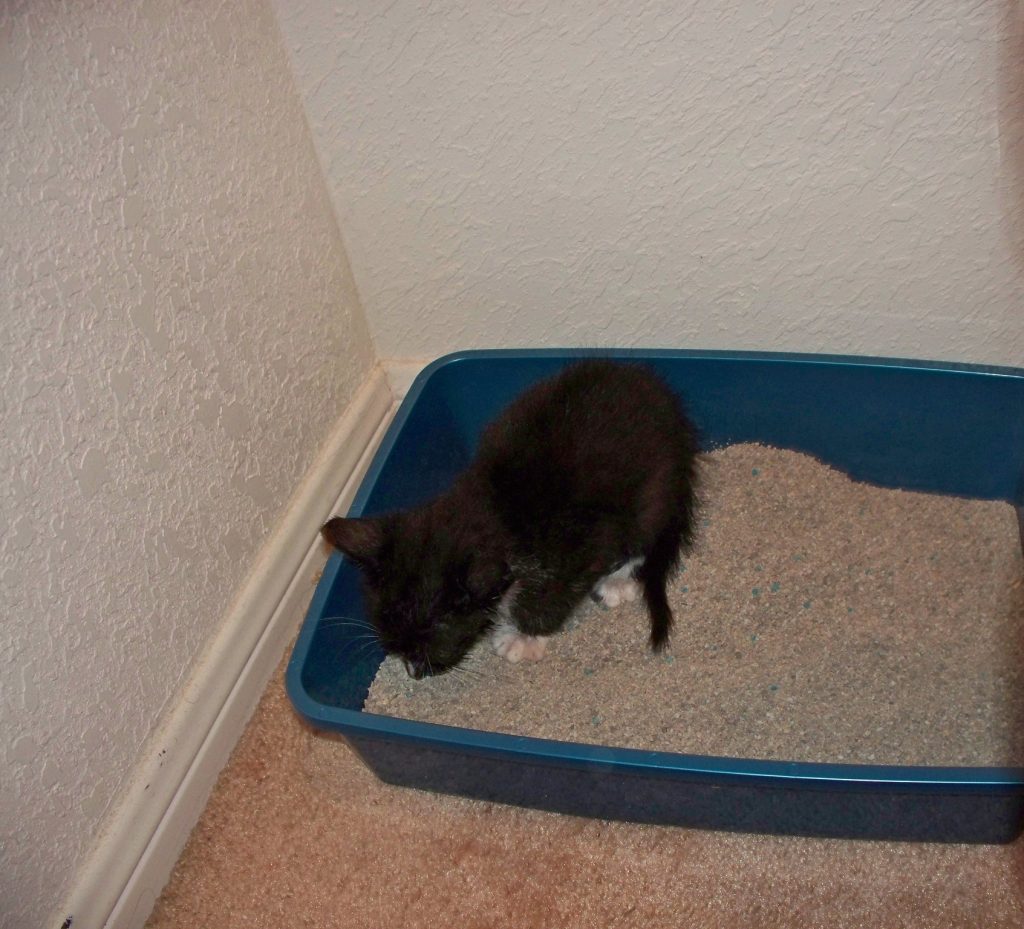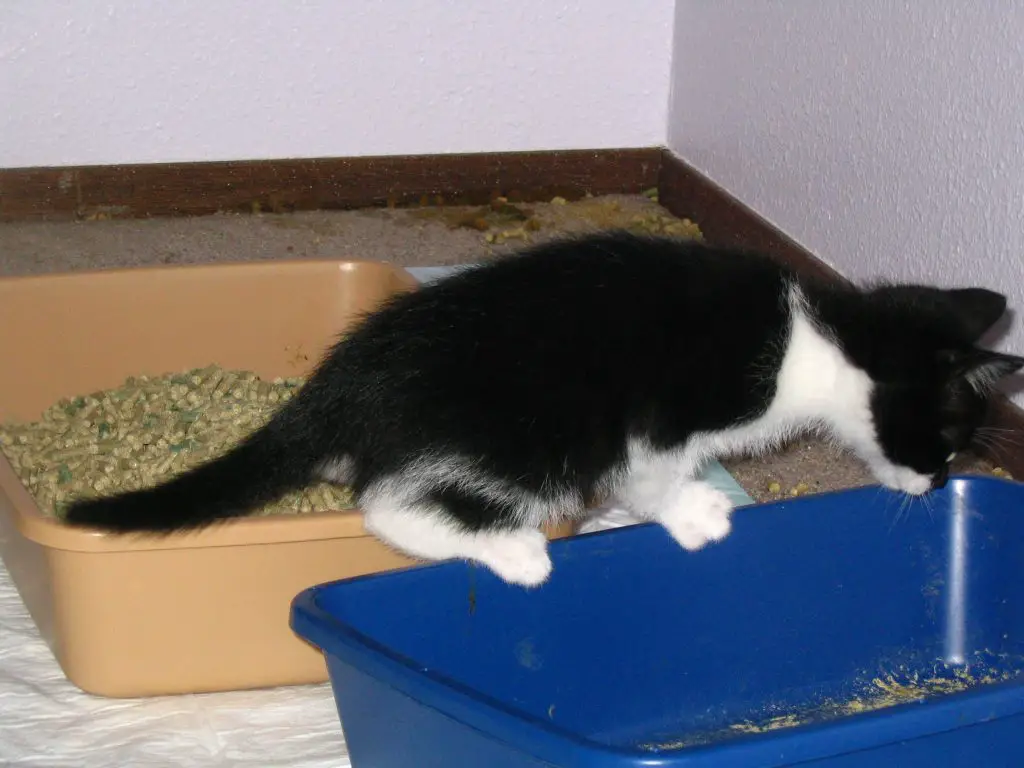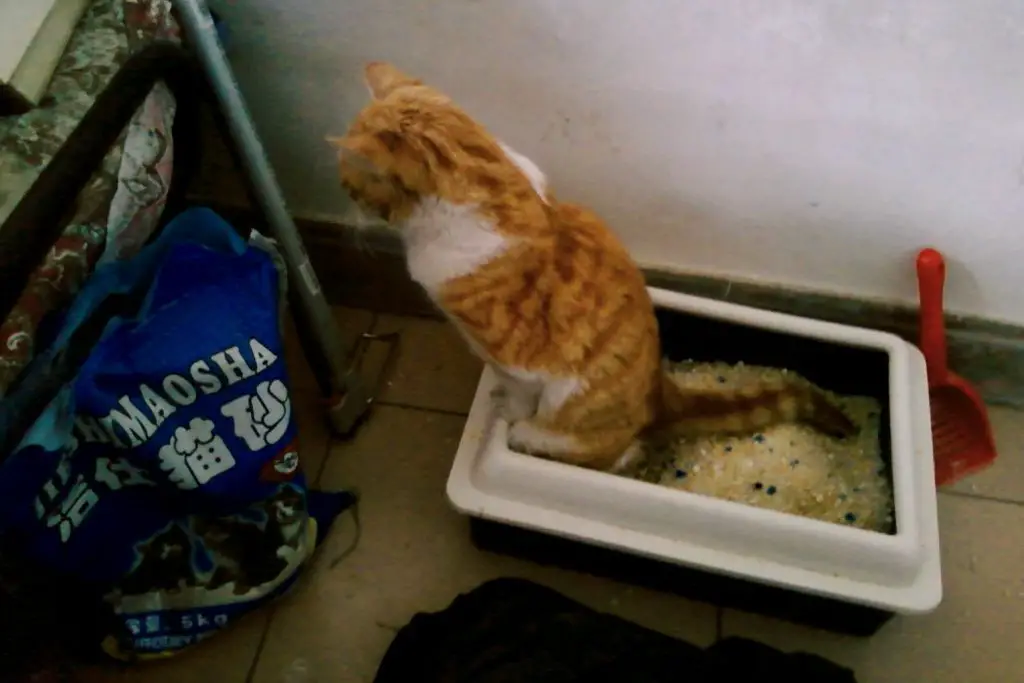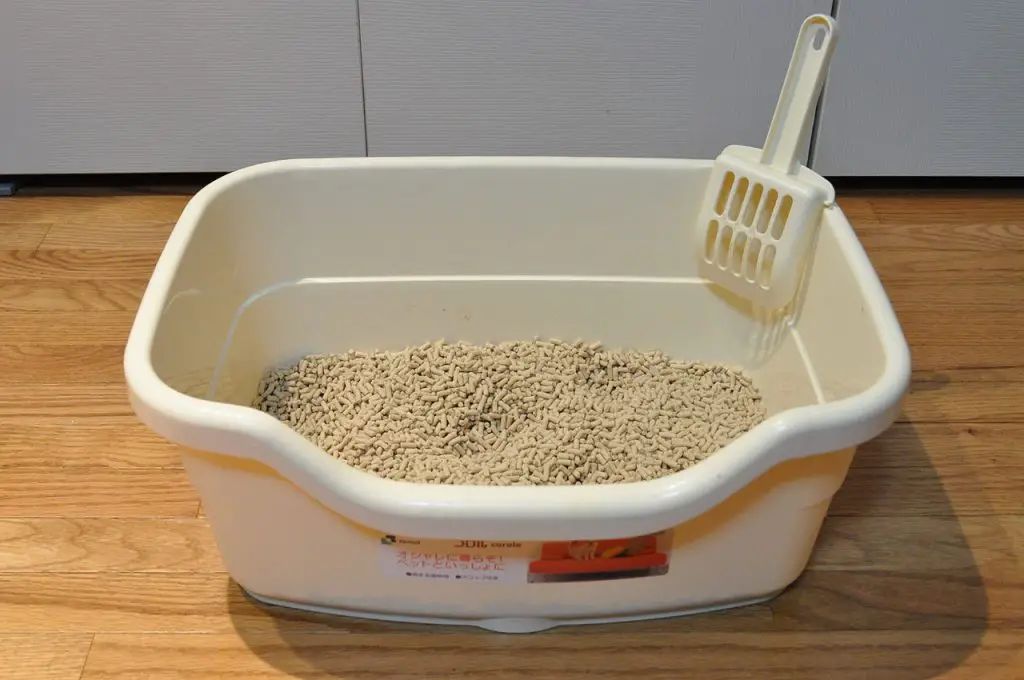If you have a new kitten, congratulations! Kittens are a lot of fun, but they can also be a lot of work. One of the most important things you will need to do is train your kitten to use the litterbox.
This can be tricky, especially if your kitten is only 8 weeks old.
In this blog post, we will discuss how to get your 8-week-old kitten to use the litterbox.
Key Takeaway
- To get your 8-week-old kitten to use the litterbox, you should confine them to one room for easy access to the box, introduce unscented non-clumping litter, place them in the box at regular intervals, particularly after meals or waking up, and use positive reinforcement like praise when they use the box correctly.
- An 8-week-old kitten should be litter trained as most kittens of this age have the physical development and curiosity necessary for litter box training, though consistency and patience are key in this process.
- If your new kitten won’t use the litter box, you should ensure the box is clean and easily accessible, try different types of litter or boxes, eliminate sources of stress, consider using a litter attractant, and consult a vet if health issues such as diarrhea are present.
How Do I Get My 8-week-old Kitten To Use The Litterbox?

Training your 8-week-old kitten to use the litterbox involves creating a conducive environment, introducing the kitten to the box, and reinforcing positive behavior.
1. Get an appropriate litter box

The first step is to select an appropriate litter box. When you bring your new kitten home, one of the first things you’ll need to do is choose a litter box. But with all the different types and sizes of litter boxes on the market, how do you know which one is right for your kitten?
Avoid using clumping litters as they can be dangerous for kittens if ingested. Instead, opt for a non-clumping clay or wheat-based litter.
Here are a few factors to consider when choosing a litter box for your kitten:
- Size: Make sure the litter box is big enough for your kitten to move around in easily. A good rule of thumb is to choose a box that’s at least twice as long as your kitten is long.
- Location: Place the litter box in an area that’s quiet and out of the way. Kittens like their privacy when they’re doing their business, so a secluded spot is ideal.
- Type of litter: There are many different types of kitten-safe litters on the market. Choose one that’s soft and absorbent, to make it comfortable for your kitten’s delicate paws.
Keep these factors in mind when choosing a litter box for your new kitten, and you’ll be sure to find one that’s purr-fect!
2. Choose the best available sand for the litter box

There are a variety of considerations to take into account when choosing the correct sand for your kitten’s litter box. The type of sand you choose will depend on your personal preferences as well as your cat’s needs. Here are a few things to keep in mind when making your decision:
- The size of the grains: Smaller grains will be more comfortable for your kitten to walk on and will also help to prevent any accidents outside of the litter box. Larger grains, on the other hand, will clump together more easily and may be more difficult for your kitten to use.
- The absorbency: You’ll want to choose sand that is highly absorbent in order to minimize odors and keep the litter box clean.
- The price: There is a wide range of prices for different types of sand, so be sure to shop around and find the best deal.
No matter what type of sand you choose, be sure to keep an eye on your kitten’s litter box habits and make changes as needed.
3. Clean the litter box frequently

It is important to scoop out the solid waste from the kitten litter box every day. In addition, you should do a complete cleaning of the kitten litter box at least once a week.
To clean the kitten litter box, empty all of the contents into a trash bag. Then, rinse out the inside of the box with warm water and soap.
Allow it to air dry before adding new litter. You should also wash your hands thoroughly after handling any soiled materials. If you have multiple cats, you will need to have a separate litter box for each cat. This will help to prevent disease and keep everyone healthy.
4. Keep in mind the size of their bladder

An 8-week-old kitten can hold about one ounce of urine. This means that they need to go about every two hours or so. However, keep in mind that every kitten is different and some may need to go more often than others.
The same goes for number two. An 8-week-old kitten can hold about a few tablespoons worth of poop for about three to four hours.
Interestingly, a kitten’s intestines continue to grow and develop throughout its first year of life. So, by the time they reach adulthood, they’ll be able to hold their pee and poo for up to twelve hours.
5. Introduce the kitten to the litter box
One of the most important things to remember is that kittens are instinctively clean creatures. So, if you provide them with a litter box and some good quality litter, they’ll likely take to it quite easily.
That said, there are a few things you can do to help them along. First, place the litter box in an area that’s quiet and away from any busy household traffic areas. This will help your kitten feel more comfortable using it without feeling like they’re being watched or disturbed.
Next, slowly introduce your kitten to the litter box by placing them in it and letting them explore at their own pace. Don’t try to force them to use it, as this will only make them more resistant.
6. Place your kitten in the litter box every two hours
Train your kitten to use the litter box. The best way to do this is to scoop your kitten up after they have finished eating or drinking and place them in the litter box. Once they have used the litter box, be sure to praise them so they know they have done something good.
Like I said before, kittens of this age can hold their bladder for up to two hours. A good rule of thumb is to place your kitten in the litter box every two hours, or five to ten minutes after they have finished eating or drinking. It is okay if they leave the litter box without finishing their business. Just be consistent and they will eventually catch up says PetMD.
7. Praise and treat when they do a good job
A great way for cats to learn that they are doing something correct is to praise them and give them a treat after a job well done. They will associate these two things very fast and will even wait for the treat after they pee or poo in their litter box.
There are a variety of good treats for kittens that you can choose from. You can give them wet food, dry food, or even some homemade kitten treats.
Just make sure that the treat is small enough for them to eat and is not too hard or chewy. Also, avoid giving them anything with artificial sweeteners as this can be harmful to their health.
What Type of Litter Should I Use For My 8-week-old Kitten?
For an 8-week-old kitten, it’s advisable to use a non-clumping, unscented litter due to their tendency to explore and ingest litter.
Choose Non-Clumping Litter
As a veterinarian, I usually recommend non-clumping litter for young kittens. At this age, kittens are curious and may ingest the litter while exploring the box. Clumping litter can cause digestive issues if ingested, so it’s safer to stick with non-clumping varieties until they’re older and less likely to eat the litter.
Opt for Unscented Litter
Scented litter might seem like a good idea to control odor, but strong fragrances can be off-putting to kittens and even cause allergic reactions in some cases. Therefore, choosing an unscented litter is typically the best option for younger kittens.
Consider the Texture
Kittens tend to prefer softer textures under their paws, which makes fine-grained litters more appealing to them. However, ensure it’s still non-clumping, as fine-grained clumping litters can clump inside a kitten’s digestive tract if ingested.
Gradually Transition to Adult Litter
Once your kitten reaches about four months of age, you can start gradually transitioning them to clumping litter if you prefer. Do this slowly by mixing increasing amounts of the new litter with the old, allowing your kitten to adjust to the change.
Should an 8-week-old Kitten Be Litter Trained?
Yes, an eight-week-old kitten can be litter-trained. You will need to be patient and consistent with your kitten, but it is definitely possible to litter train an eight-week-old. Here are a few tips to help you get started:
– Choose a litter that your kitten likes. Some kittens prefer softer litters while others like clumping litters. Experiment until you find one that your kitten seems to prefer.
– Put the litter box in a quiet, out-of-the-way place. Kittens feel safest when they have some privacy, so make sure the litter box is in a place where your kitten can relax and do its business without being disturbed.
– Reward your kitten for using the litter box. Every time your kitten uses the litter box, give it a small treat or some extra attention. This will help your kitten associate the use of the litter box with something positive.
With some patience and consistency, you should be able to successfully litter train your eight-week-old kitten. Good luck!
What Do You Do If Your New Kitten Won’t Use The Litter Box?
If your new kitten won’t use the litter box, steps to take include maintaining a clean litter box, experimenting with new litter or box types, reducing stressors, using litter attractants, and consulting a vet if health issues are suspected.
Maintain a Clean Litter Box
As a veterinarian, I’ve observed that cats are clean animals by nature and prefer their toilet area to be kept tidy. Ensuring the litter box is regularly cleaned can encourage your kitten to use it more frequently. If the box is not clean, the kitten might avoid it and find other places to do their business.
Experiment with New Litter, Boxes, or Locations
Different kittens may have different preferences when it comes to the type of litter, the design of the box, or the location of the box. Some kittens might prefer unscented litter, while others might be more comfortable with certain box designs. Moving the litter box to a quiet, low-traffic area can also make the kitten more comfortable.
Reduce Stressors
Stress can affect a kitten’s behavior, including their use of the litter box. Ensuring your kitten feels safe and secure can help them adapt better to their new environment, including using the litter box consistently. This could involve minimizing loud noises, providing plenty of hiding spaces, and giving them time to adjust to new people or pets.
Use Litter Attractants
Litter attractants can be a useful tool for encouraging your kitten to use the litter box. These products contain scents that appeal to cats and can draw them to the box.
Consult a Vet for Health Issues
In some cases, a kitten might avoid the litter box due to health issues. For instance, a kitten with diarrhea might associate the litter box with discomfort and thus avoid it.
As a vet, I would recommend seeking professional advice if you suspect your kitten might be avoiding the litter box due to health problems. A vet can provide a diagnosis and appropriate treatment to help your kitten get back on track.
What Is The Fastest Way To Litter Train a Kitten?
The fastest way to litter train a kitten involves setting up an appropriate and accessible litter box, showing them how to use it, maintaining a clean environment, and rewarding good behavior.
Set Up an Appropriate Litter Box
As a vet, I always advise my clients to start with the right setup. Choose a litter box with low sides for easy access and fill it with unscented, dust-free, clumping cat litter. The box should be large enough for your kitten to move around freely. Place the box in a quiet, easily accessible location away from food and water dishes.
Show Them How to Use It
Next, introduce your kitten to the litter box. Gently place them in the box and softly scratch their front paws in the litter to mimic digging. Avoid forcing them to stay if they want to leave. Most kittens instinctively understand what the box is for after a few introductions.
Maintain a Clean Environment
Cats are naturally clean animals and prefer to do their business in a clean area. Make sure to scoop the litter box at least once a day and change the litter completely every week. This will help encourage your kitten to consistently use the box.
Reward Good Behavior
Positive reinforcement can be very effective. Whenever your kitten uses the litter box correctly, reward them with praise, petting, or a small treat. This helps to reinforce the positive behavior and makes them more likely to repeat it.
Monitor for Any Issues
Lastly, keep a close eye on your kitten’s litter box habits. If you notice any changes such as refusal to use the box, inappropriate elimination, or signs of discomfort while urinating, consult a vet immediately. These could be signs of medical issues that need to be addressed promptly.
FAQs
Q: Where should I place the litterbox for my 8-week-old kitten?
A: Choose a quiet and easily accessible location for the litterbox. Avoid placing it near their food and water bowls as cats prefer separate areas for their toilet needs.
Q: How often should I clean the litterbox for my 8-week-old kitten?
A: Clean the litterbox at least once a day. Kittens are very clean animals and may find alternate places to eliminate if the litterbox is dirty.
Q: What should I do if my 8-week-old kitten refuses to use the litterbox?
A: Ensure that the litterbox is clean and accessible. If your kitten continues to avoid using the litterbox, consult your veterinarian as there may be underlying health issues or behavioral concerns that need to be addressed.
Q: Should I use any specific training techniques to teach my 8-week-old kitten to use the litterbox?
A: Positive reinforcement is key in litterbox training. Praise and reward your kitten with treats or gentle petting when they use the litterbox correctly. Avoid punishment or scolding if accidents occur, as this can create fear and anxiety around the litterbox.
Q: How long does it usually take for an 8-week-old kitten to learn to use the litterbox?
A: Every kitten is different, but most kittens learn to use the litterbox within a few weeks. Patience and consistency in training will help them understand the desired behavior.
Q: Can I use a covered litterbox for my 8-week-old kitten?
A: It is best to start with an uncovered litterbox for young kittens. Covered litterboxes may feel confined or dark, potentially making them uncomfortable for your kitten. Once they are consistently using the litterbox, you can gradually transition to a covered one if desired.
Q: What should I do if my 8-week-old kitten has accidents outside the litterbox?
A: Clean up accidents promptly and thoroughly to remove any lingering scent. Use an enzyme-based cleaner specifically designed for pet messes to eliminate odors and prevent your kitten from being attracted to the same spot.
Q: How can I prevent my 8-week-old kitten from tracking litter around the house?
A: Place a litter mat or tray outside the litterbox to catch any litter that may stick to your kitten’s paws. Regularly vacuum or sweep around the litterbox area to keep the floor clean.
Conclusion and final thoughts
In conclusion, getting an 8-week-old kitten to use the litterbox can be a challenging but necessary task for any new pet owner.
It requires patience, consistency, and understanding of your kitten’s behavior and needs.
By following the tips mentioned in this blog post, such as providing a suitable litterbox, using positive reinforcement, and proper cleaning techniques, you can successfully train your kitten to use the litterbox and establish good bathroom habits for their future.




